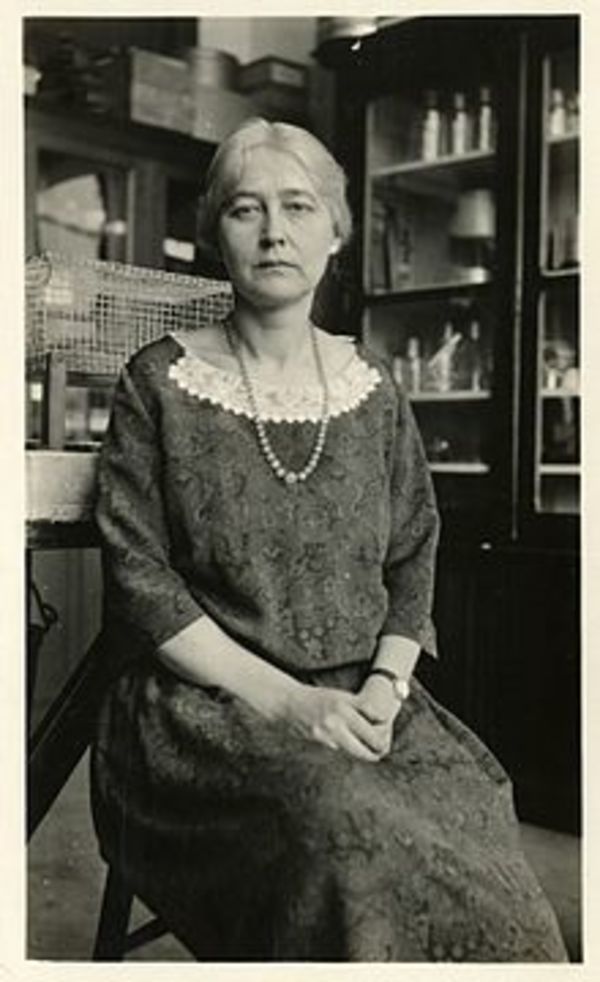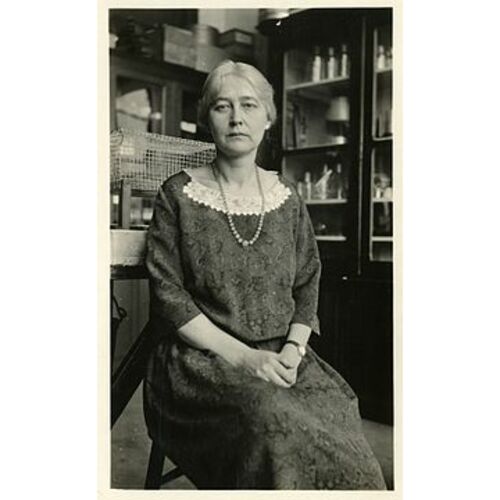
Source: Courtesy of Wikimedia Commons
MENTEN, MAUD LEONORA (named at birth Maud, she added Lenora around 1900 and later spelled it Leonora), educator, research scientist, biochemist, and pathologist; b. 20 March 1879 in Lambton County, Ont., daughter of Charles William Menten and Emma Trusler; d. unmarried 17 July 1960 in Leamington, Ont., and was buried in Chilliwack, B.C.
Maud Menten’s family moved in 1889 to the small community of Harrison River (Harrison Mills), B.C., where her father operated boats and was the postmaster. Her mother, who ran the general store and hotel, probably gave lessons to Maud and her younger brother until 1892, when a one-room schoolhouse opened on distant Fairfield Island (Chilliwack). Maud, who had to travel by canoe and pony each day to attend class, grew up playing with white and indigenous children and learned to speak Chinook Jargon [see Jean-Marie-Raphaël Le Jeune*]. She started high school in Chilliwack in September 1894, graduated in 1897, and taught for three years at a small rural school in nearby Camp Slough. She then enrolled in University College at the University of Toronto, where she completed a ba (1904) with honours in natural science and English. While studying there for her mb, she was employed for two years as an assistant demonstrator in physiology by Professor Archibald Byron Macallum*, with whom she published a paper on the distribution of chlorides in nerve cells and fibres in the Proceedings of the Royal Society of London in 1906. It was in this laboratory that Menten researched her first independently written paper, on the distribution of fat, chlorides, phosphates, potassium, and iron in striated muscle, which appeared four years later.
After earning her mb (1907), Menten found a position at the Rockefeller Institute for Medical Research in New York. There she and pathologists Simon Flexner and James W. Jobling produced a collection of monographs, the first released by the institute, in 1910. (Her contribution to the volume was on the influence of radium bromide on a transplantable rat tumour.) After a brief internship at the New York Infirmary for Women and Children, Menten worked in the laboratory of American surgeon George Washington Crile at Cleveland’s Western Reserve University in Ohio before returning to Toronto and completing her md (1911). In 1912 she went to Berlin to work with German biochemist Leonor Michaelis, and the following year they published their famous paper in Biochemische Zeitschrift on what would become known as the Michaelis-Menten equation. This formula, which provides a mathematical way of relating the rate of an enzyme-catalysed reaction to the concentration of the substrate on which the enzyme acts, would still be essential fundamental knowledge taught to all biochemists in the early 21st century.
Between 1914 and 1916 Menten carried out further investigations in Cleveland, did research on cancer at the Barnard Free Skin and Cancer Hospital in St Louis, Mo., and obtained her phd in biochemistry from the University of Chicago. She would spend the next 34 years of her life in Pittsburgh, Pa, where she joined the staff of the Elizabeth Steel Magee Hospital and, in 1918, received a faculty appointment as a full-time demonstrator in the University of Pittsburgh School of Medicine’s department of pathology. She was made assistant professor in 1923, associate professor in 1925, and full professor in 1949. From 1926 until her retirement from the university in 1950, she was also pathologist to the Children’s Hospital of Pittsburgh.
Menten, who was known for working 18-hour days, maintained a heavy teaching schedule while devoting herself to research on the pathology and histochemistry of various organs under normal and abnormal conditions. She studied tumours and a wide range of children’s diseases, including scarlet fever, pneumonia, cystic fibrosis, and meningitis, and also investigated bacterial toxins and treatments such as sulphonamide therapy. More than 90 publications resulted from her work, and she was an active member of at least eight medical and scientific societies, including the American College of Physicians, the College of American Pathologists, and the American Physiological Society.
The research done by Menten and her colleagues at Pittsburgh produced several noteworthy achievements. In 1925 they discovered the hyperglycaemic effect of salmonella toxin, and nine years later their studies on vitamin C detailed the pathological changes in the organs of scorbutic guinea pigs. In 1944 they developed a technique for producing a histochemical azo dye–coupling reaction for alkaline phosphatase. This accomplishment, described in what would be their most frequently cited work, opened up the field of histochemistry and was later described by Anthony Guy Everson Pearse, a prominent English histochemist, as a “stroke of genius.” Also in 1944, Menten’s team was the first to use electrophoresis to examine adult and fetal hemoglobins, although this pioneering work has seldom been recognized.
Menten had talents in several fields outside science. She was an accomplished painter whose oil landscapes and still lifes hung in art exhibitions, she played the clarinet, and she spoke German, French, Italian, and Russian, as well as the pidgin she had learned as a child. She enjoyed outdoor activities such as camping and mountain climbing, and was interested in astronomy. Her niece Dorothy E. Craig would recall in 1979 that her aunt “was a marvellous companion – energetic, tireless, anxious to do and see everything. She made friends everywhere she went.… She tried to instill in us her self-reliance and zest for life. Age and sex were no barriers. The desire to achieve was drive enough. She was really ahead of her time.” Menten’s colleagues in Pittsburgh regarded her as difficult to please and demanding of hard work, but they also described her as “an inspiring teacher who stimulated medical students, resident physicians and research associates to their best efforts.” A modest person, she had a dignity of manner that was tempered occasionally by her dry wit.
After leaving Pittsburgh in 1950, Maud Menten undertook cancer research at Vancouver’s British Columbia Medical Research Institute until severe arthritis forced her to retire completely four years later. She then moved to Leamington, Ont., where she was cared for by relatives until her death on 17 July 1960. Her obituary in Nature, written by her former colleagues in Pittsburgh, emphasizes that she was “untiring in her efforts on behalf of sick children.” Her life and achievements have been commemorated in several ways. In 1979 the Ontario Heritage Foundation placed a plaque in her honour outside the Medical Sciences Building of the University of Toronto, and in 2006 a sculpture of Menten was unveiled in the main lobby of the university’s Terrence Donnelly Centre for Cellular and Biomolecular Research. The inscription identifies her (along with Sir Frederick Grant Banting* and Charles Herbert Best*) as one of the ten giants of biomedical science who began their careers or established their reputations at the university. A year later the department of biochemistry at the University of Western Ontario inaugurated an annual Maud L. Menten Memorial Lecture Series. At the University of Pittsburgh, the Pathology Education and Research Foundation established the Annual Maud L. Menten Lecture in 1982, and six years later, with alumni assistance, the Maud L. Menten Professorship in Experimental Pathology. She was inducted in 1998 into the Canadian Medical Hall of Fame.
Maud Leonora Menten is the author or co-author of more than 90 publications. The following list includes her first, last, and most important works: “On the distribution of chlorides in nerve cells and fibres,” Royal Soc., Proc. (London), ser.B, 77 (January–June 1906): 165–93; “The distribution of fat, chlorides, phosphates, potassium and iron in striated muscle,” Canadian Instit., Trans. (Toronto), 8 (1910): 403–21; “Experiments on the influence of radium bromide on a carcinomatous tumor of the rat,” Monographs on Medical and Allied Subjects (New York), no.1 (30 June 1910): 73–80; “Die Kinetik der Invertinwirkung,” Biochemische Zeitschrift (Berlin), 49 (1913): 333–69; “The action of adrenalin on the blood,” American Journal of Physiology (Bethesda, Md), 44 (August–November 1917): 176–95; “Relationship of enteritidis-paratyphoid B infections to hyperglycemia in rabbits,” Journal of Infectious Diseases (Chicago), 37 (1925): 400–10; “Pathologic changes in the organs of scorbutic guinea pigs,” Soc. for Experimental Biology and Medicine, Proc. (Baltimore, Md), 31 (October 1933–June 1934): 455–60; “A coupling histochemical azo dye test for alkaline phosphatase in the kidney,” Journal of Biological Chemistry (Bethesda), 153 (April–May 1944): 471–77; “Sedimentation constants and electrophoretic mobilities of adult and fetal carbonylhemoglobin,” Journal of Biological Chemistry, 153: 301–05; and “Changes in nucleic acids of cells of mouse mammary carcinoma following exposure to X-ray of low dosage,” Experimental Cell Research (New York), 7 (1954): 83–94. A complete bibliography of her publications is held in the Menten file in the DCB office.
Arch. of Ont. (Toronto), RG 80-2-0-128, no.12775. Private arch., M. A. Packham (Toronto), Personal communication with J. R. Barberie, great-nephew of Maud Menten; Personal communication with Dr Lynn Weir, Dept. of Biochemistry, Western Univ. Univ. of Toronto Arch. and Records Management Services, A1973-0026/318 (11a); A2003-0005/118. Leamington Post and News (Leamington, Ont.), 21 July 1960. Canadian Medical Hall of Fame, “Maud L. Menten, md”: www.cdnmedhall.org/inductees/maudmenten (consulted 2 March 2020). K. A. Johnson and R. S. Goody, “The original Michaelis constant: translation of the 1913 Michaelis-Menten paper,” Biochemistry (Washington), 50 (2011): 8264–69. “The Menten plaque,” Canadian Biochemical Soc., Bull. ([Quebec]), 16 (1979), no.2: 27–31. A. G. E. Pearse, Histochemistry, theoretical and applied (London, 1953). Rebecca Skloot, “Some called her Miss Menten,” Pittmed (Pittsburgh, Pa), 2 (2000), no.4: 18–21. Daphne Sleigh, The people of the Harrison (Deroche, B.C., 1990). A. H. Stock and A.‑M. Carpenter, “Prof. Maud Menten,” Nature (London), 25 March 1961: 965. Torontonensis (Toronto), 1907: 174.
Cite This Article
Marian A. Packham, “MENTEN, MAUD LEONORA (Maud, Lenora, Leonora),” in Dictionary of Canadian Biography, vol. 18, University of Toronto/Université Laval, 2003–, accessed April 8, 2025, https://www.biographi.ca/en/bio/menten_maud_leonora_18E.html.
The citation above shows the format for footnotes and endnotes according to the Chicago manual of style (16th edition). Information to be used in other citation formats:
| Permalink: | https://www.biographi.ca/en/bio/menten_maud_leonora_18E.html |
| Author of Article: | Marian A. Packham |
| Title of Article: | MENTEN, MAUD LEONORA (Maud, Lenora, Leonora) |
| Publication Name: | Dictionary of Canadian Biography, vol. 18 |
| Publisher: | University of Toronto/Université Laval |
| Year of revision: | 2021 |
| Access Date: | April 8, 2025 |



